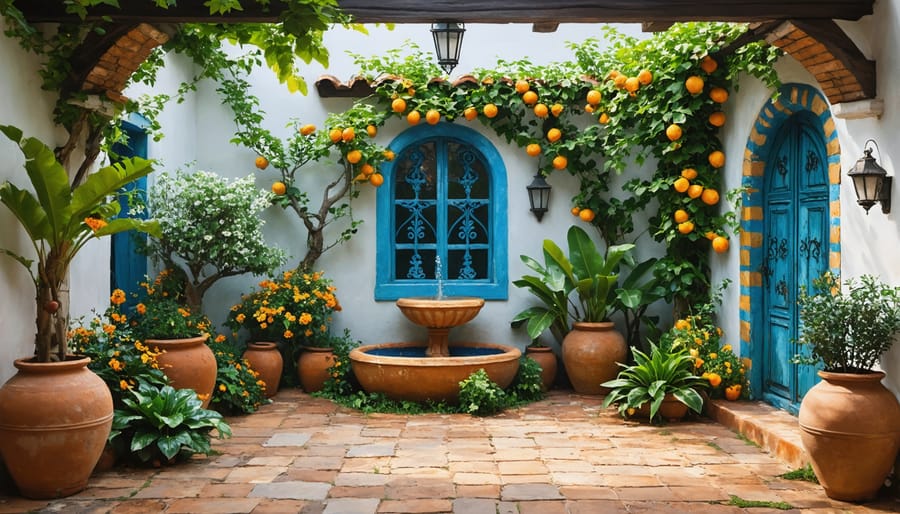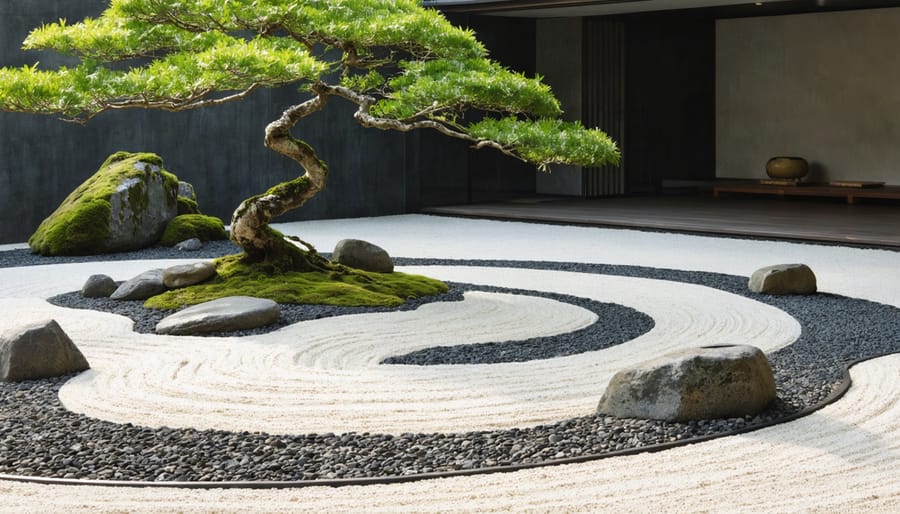Spain’s colonial empire stands as one of history’s most transformative forces, reshaping not only global trade and cultural exchange but also the very way we approach spiritual garden design and agricultural practices today. From 1492 to the early 1800s, Spanish explorers and settlers introduced revolutionary farming techniques and exotic plants across their vast territories, creating an unprecedented botanical exchange between Europe, the Americas, and the Philippines. This agricultural revolution brought tomatoes, potatoes, and corn to European tables, while Spanish missionaries established elaborate garden systems that combined Old World aesthetics with indigenous growing methods. The empire’s influence extended beyond mere cultivation, developing sophisticated irrigation systems and architectural elements that continue to inspire modern garden designers. These colonial gardens, with their distinctive blend of formal European layouts and tropical abundance, demonstrate how cultural exchange can create enduring botanical legacies that enrich our understanding of sustainable and adaptive gardening practices.
The Birth of Colonial Garden Exchange
Mediterranean Meets the Americas
The exchange of plants between Spain and its American colonies created one of history’s most fascinating garden transformations. Spanish ships carried familiar Mediterranean crops like olive trees, grape vines, and wheat to the New World, helping colonists establish familiar foods in unfamiliar soil. These European plants found new homes in colonial gardens, where they gradually adapted to different growing conditions.
In return, Spanish explorers discovered a treasure trove of New World plants that would revolutionize European gardens and cuisine. Tomatoes, potatoes, corn, and beans made their way across the Atlantic, though it took time for Europeans to embrace these unfamiliar foods. The humble potato, initially viewed with suspicion, would later become a staple crop throughout Europe.
This botanical exchange wasn’t just about food – ornamental plants also made the journey. Dahlias from Mexico and sunflowers from North America soon decorated Spanish gardens, while Mediterranean herbs like rosemary and thyme found new purpose in colonial cooking. These plant exchanges created lasting connections between two worlds, influencing how we garden and eat to this day.
The Manila Galleon Trade
The Manila Galleon Trade, spanning from the 16th to early 19th centuries, created one of history’s most fascinating plant exchanges. These Spanish trading ships, traveling between Manila and Acapulco, didn’t just carry silver and spices – they transformed gardens on both sides of the Pacific Ocean. Think of these galleons as floating gardens, introducing Asian plants to the Americas and American plants to Asia.
Imagine tropical fruits like mangoes and tamarind making their first journey to Mexican soil, while American crops like sweet potatoes, corn, and chili peppers sailed westward to the Philippines. These ships also carried valuable seeds and cultivation techniques between continents. Spanish missionaries and traders carefully documented these botanical treasures, keeping detailed records of growing methods and plant uses.
The legacy of this trade route lives on in today’s gardens. Many plants we consider native to certain regions actually arrived via these galleon routes. When you bite into a Philippine mango or admire Mexican chili peppers, you’re experiencing the living history of this remarkable exchange that forever changed our garden landscapes.


Legacy Plants in Today’s Gardens
New World Treasures
When Spanish explorers returned from the Americas, they brought back botanical treasures that would forever change European gardens and cuisine. The humble tomato, initially viewed with suspicion and grown purely as an ornamental plant, gradually became a cornerstone of Mediterranean cooking. These bright red fruits, along with an array of vibrant peppers, transformed not only Spanish gardens but eventually spread throughout Europe.
Sweet and hot peppers quickly found their way into traditional Spanish dishes, while potatoes – another New World discovery – proved to be a resilient crop that could thrive in various European climates. Corn, beans, and squash, known as the “Three Sisters” by Native Americans, also enriched European garden beds with their complementary growing patterns.
Perhaps less known but equally important were flowers like marigolds, which Spanish gardeners prized for their bright colors and natural pest-deterrent properties. Sunflowers, native to North America, became popular in European gardens for both their impressive height and useful seeds. Even chocolate, derived from cacao trees, started its journey to becoming a European delicacy through Spanish colonial trade routes.
Today, many gardeners might be surprised to learn that these now-common plants were once exotic treasures that sparked a revolution in European horticulture. Their introduction not only diversified gardens but also played a crucial role in developing the rich tapestry of Mediterranean cuisine we know today.
Asian Influences
The Spanish colonial trade routes brought more than just gold and spices to Europe – they introduced numerous Asian plants that would forever change European and American gardens. During the Manila Galleon trade, Spanish ships transported exotic specimens from the Philippines and other Asian territories, creating a fascinating botanical exchange that continues to influence gardens today.
Among the most significant Asian plants introduced were citrus varieties, particularly the calamansi and pomelo. These citrus fruits found their way into Spanish gardens before spreading throughout Europe and eventually to the Americas. Jasmine varieties from China and Southeast Asia became prized additions to Spanish gardens, valued for their intoxicating fragrance and delicate flowers.
Ornamental bamboo species from Asia also made their journey westward, offering European gardeners new possibilities for creating screens and architectural elements in their gardens. The Japanese maple, though not directly traded by the Spanish, found its way to Europe through these established trade networks.
Perhaps most importantly, the Spanish colonial trade introduced several medicinal plants from Asia, including turmeric and ginger, which were initially grown in monastery gardens for their healing properties. These plants not only served practical purposes but also added exotic beauty to European gardens, creating a lasting legacy of botanical diversity that gardeners still enjoy today.
The integration of these Asian plants demonstrates how colonial trade routes enriched gardening traditions across continents, creating the diverse and vibrant gardens we cherish today.
Garden Design Elements That Endure
Courtyard Gardens
Spanish courtyard gardens, or patios, represent one of the most enduring legacies of Spain’s colonial influence, combining practical design with stunning aesthetics. These intimate outdoor spaces traditionally featured a central fountain, geometric patterns, and carefully planned plantings that created a sacred garden sanctuary within the home.
The design principles of Spanish courtyard gardens remain remarkably relevant today. Their emphasis on water conservation through clever irrigation systems and shade-creating pergolas makes them particularly suitable for modern sustainable gardening. Traditional elements like terracotta pots, climbing vines, and fragrant citrus trees can easily be adapted to contemporary spaces, regardless of size.
What makes these gardens particularly special is their focus on multi-sensory experiences. The gentle splash of fountains provides a cooling effect and masks urban noise, while aromatic plants like jasmine and lavender create a perfumed atmosphere. The use of tiles, both on walls and walkways, adds visual interest and reflects light into shaded areas.
For today’s gardeners, Spanish courtyard principles offer practical solutions for creating outdoor living spaces that feel both private and connected to nature. Even small urban patios can incorporate these elements, using container gardening, vertical plantings, and strategic seating areas to capture the essence of these historical spaces while meeting modern needs.

Water Features and Fountains
Water features played a vital role in Spanish colonial gardens, reflecting both practical necessity and artistic expression. The Spanish brought their expertise in water management, developed during centuries of Moorish influence, to their colonies. These gardens typically featured elaborate fountains, cooling pools, and innovative irrigation systems that combined beauty with functionality.
Today, many gardeners draw inspiration from these colonial designs to create their own peaceful meditation space using water features. The gentle sound of flowing water, characteristic of Spanish colonial fountains, helps mask urban noise while creating a serene atmosphere.
Traditional Spanish-style fountains often incorporate tiered designs with decorative basins, typically crafted from materials like terra cotta or carved stone. Modern interpretations might use more affordable materials while maintaining the classic aesthetic. Wall fountains, particularly popular in colonial courtyards, remain an excellent choice for smaller gardens or patios.
For sustainable gardening enthusiasts, it’s worth noting that many colonial water systems were remarkably efficient. They used gravity-fed channels and catchment areas to conserve water – principles that remain relevant for today’s water-conscious gardeners. When planning your own Spanish-inspired water feature, consider incorporating these time-tested techniques with modern water-recycling systems to create an eco-friendly garden element that honors this rich historical tradition.
Growing Colonial Heritage Plants
Bringing a touch of Spanish colonial heritage to your garden is easier than you might think. Many plants that were cultivated during Spain’s colonial period are both beautiful and remarkably adaptable to modern gardens. When creating tranquil garden spaces, these historic varieties can add both visual interest and cultural significance.
Start with tomatoes, which Spanish colonists helped spread worldwide. Cherry tomatoes are perfect for beginners and can thrive in containers or small spaces. Plant them in well-draining soil with full sun exposure, and you’ll enjoy a taste of history right from your garden.
Peppers, another colonial-era favorite, are equally rewarding to grow. Try starting with sweet bell peppers before advancing to spicier varieties. These plants love warm weather and make excellent companion plants for tomatoes.
For ornamental appeal, consider growing marigolds, which held both decorative and medicinal importance in colonial gardens. These cheerful flowers are easy to maintain and naturally repel many garden pests. Plant them around your vegetables for natural pest control.
Herbs like sage, rosemary, and thyme were essential in colonial gardens for both cooking and medicine. These Mediterranean natives are drought-resistant and perfect for sunny spots with well-draining soil. They also work wonderfully in container gardens.
When planning your colonial heritage garden, remember these key tips:
– Choose a sunny location with good drainage
– Group plants with similar water needs together
– Incorporate raised beds for better soil control
– Use traditional terra cotta pots for authenticity
– Consider vertical growing methods for vining plants
Remember to start small and gradually expand your colonial garden collection. Many of these plants are surprisingly hardy and will reward you with both beauty and functionality, just as they did centuries ago.
The influence of Spanish colonial gardening practices continues to shape modern horticulture in remarkable ways. Today’s gardeners often unknowingly implement techniques that were refined during Spain’s colonial period, from water conservation methods to the integration of ornamental and edible plants in the same space. These colonial gardens weren’t just beautiful; they were practical blueprints for sustainable living that remain relevant centuries later.
The Spanish colonial approach to garden design, with its emphasis on courtyards and water features, has inspired countless modern gardens, particularly in regions with similar climates. Their innovative irrigation systems, including the acequia method of water distribution, continue to influence sustainable water management practices in contemporary gardening.
Many of the plants introduced during the colonial period have become staples in today’s gardens worldwide. Tomatoes, peppers, and various herbs that we now consider essential to Mediterranean and American gardens were first cultivated on a large scale during this era. The Spanish colonial practice of companion planting and creating microclimates within gardens has also found new appreciation among modern organic gardeners.
Perhaps most significantly, the colonial Spanish garden’s philosophy of blending beauty with utility has become increasingly relevant in today’s movement toward sustainable and productive home gardens. This lasting legacy reminds us that good gardening practices truly stand the test of time, offering valuable lessons for creating beautiful, productive, and sustainable gardens in our modern world.




